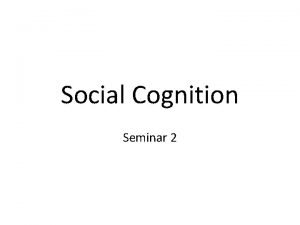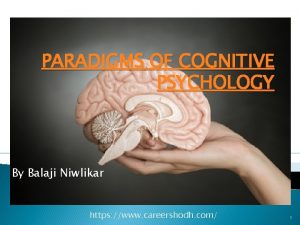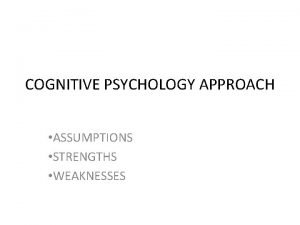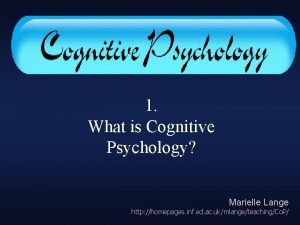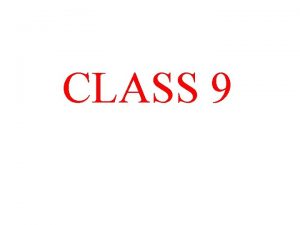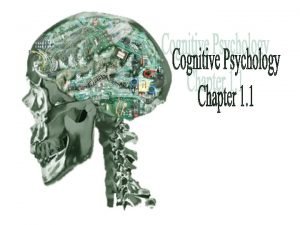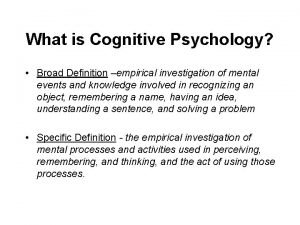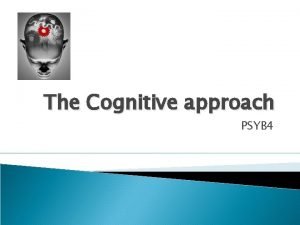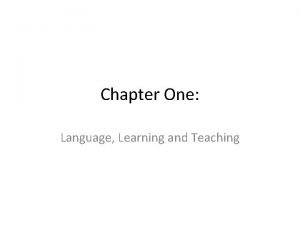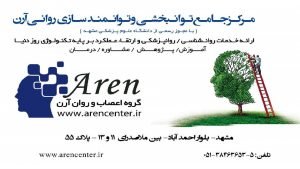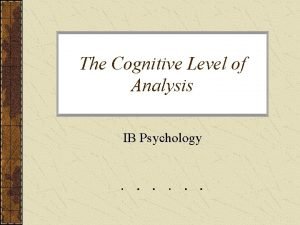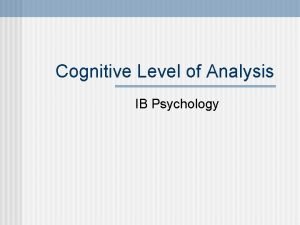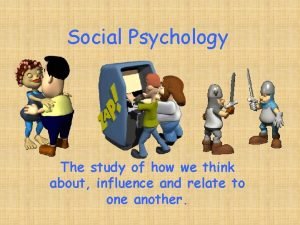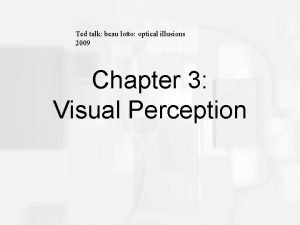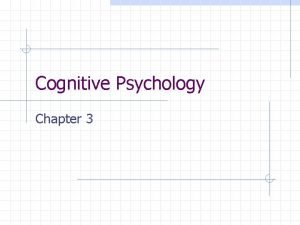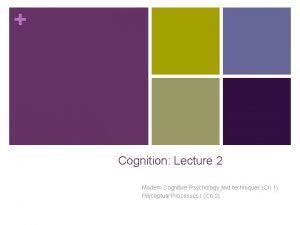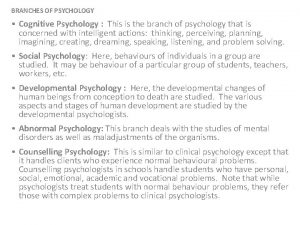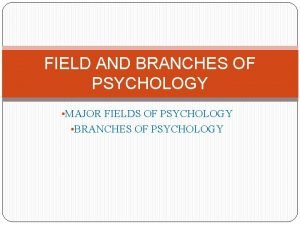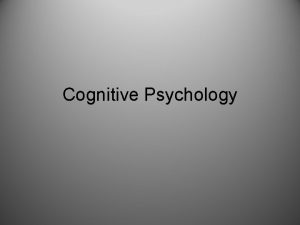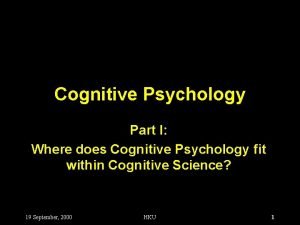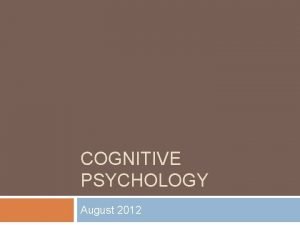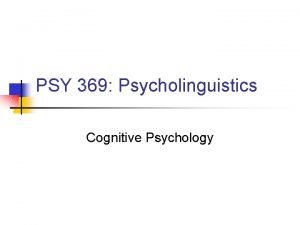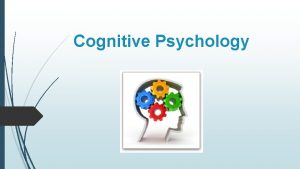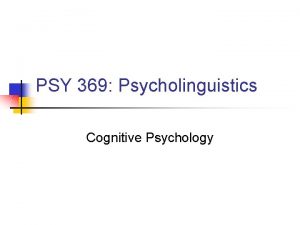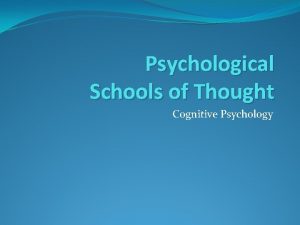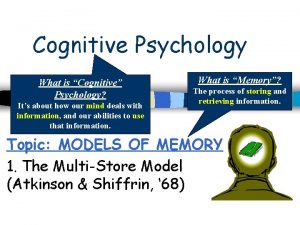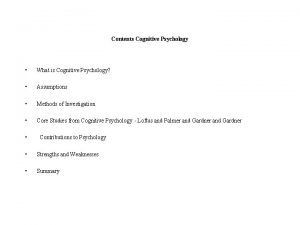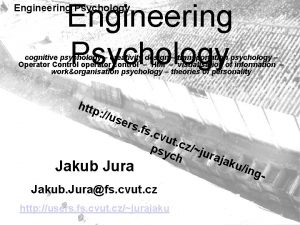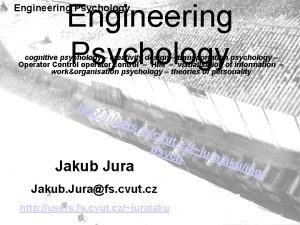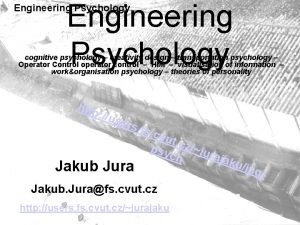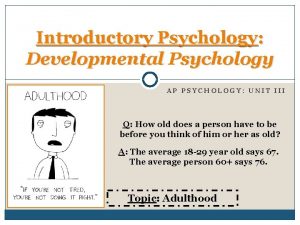Cognitive Psychology Part III Some research areas within

































- Slides: 33

Cognitive Psychology Part III: Some research areas within Cognitive Psychology 21 September, 2000 HKU 1

Categorization Representation Memory Attention 21 September, 2000 HKU 2

Categorization “The process by which distinct entities are treated as equivalent” (Medin & Aguilar, 1999) 21 September, 2000 HKU 3

21 September, 2000 HKU 4

21 September, 2000 HKU 5

Categorization (Categorical Perception) Partitioning a continuous physical spectrum into discrete categories 21 September, 2000 HKU 6

Color Perception 21 September, 2000 HKU 7

Why categories? • The world is very complex. – We cannot keep track of every individual item in the world – we must group similar things together. – We cannot process all information available to us – we must selectively attend to what is important to us (what is important for making these groupings). 21 September, 2000 HKU 8

Some questions about categories • What information and processes do we use to form categories? • How does using categories affect our perception and behavior? 21 September, 2000 HKU 9

Representation How is information represented in the mind? 21 September, 2000 HKU 10

What is a mental representation? • A systematic correspondence between some element of a target domain and some element of a modeling (or representation) domain. 21 September, 2000 HKU 11

For example Target domain (real world) 21 September, 2000 Model domain (representation) HKU 12

• The target contains 3 rectangles. • The model contains 3 sets of dots. • The relevant structure in the target is the height of the rectangles. • The relevant structure in the model is the number of dots (height, width is irrelevant). • Systematic correspondence is that the number of dots increases as the height of the rectangle increases. 21 September, 2000 HKU 13

An alternative 20 Target domain (real world) 21 September, 2000 4 8 Model domain (representation) HKU 14

And another A Target domain (real world) 21 September, 2000 C B Model domain (representation) HKU 15

Possible representations • Symbols: Representations are amodal – they bear no necessary resemblance to the concept or percept they represent. The systematic correspondence between the two domains may be a matter of convention (only). – Like variables in algebra, the words dog, Hund, [sabaka] and [gau 2], or the numerals 20, 4, and 8, or A, B, and C, for the rectangles in the rectangle example. 21 September, 2000 HKU 16

Possible representations • Images: Representations resemble what they represent in some non-arbitrary way. The systematic correspondence between the two domains is iconic. – e. g. photographs, maps, caricatures, the number of dots for height (number of cm), etc. 21 September, 2000 HKU 17

Symbols vs. Images • It seems almost obvious that some things might be represented as images – visual percepts: • It seems less obvious that other things are represented as images – abstract concepts: The feeling of being tired of hearing about brown dogs. • Some things seem to fall somewhere in between. – The concept of dog (not a particular dog, but dogness in general). 21 September, 2000 HKU 18

Evidence for mental images • Pictures of abstract 3 D objects. • Object-matching task: “Are these two objects the same or not? ” • On correct “same” responses, subject took longer when there was a greater angle of rotation between the two objects. • This suggests they were rotating the images until they matched up in their “mind’s eye”. (From Shepard & Metzler, 1971) 21 September, 2000 HKU 19

More evidence of mental imagery • Property-listing task: “Name all the properties you can think of that are true of…” • Watermelon – Green, round, heavy, buy them in the summer, etc. • Half of a watermelon – Pink, has seeds, wet, sweet, heavy, etc. • Responses depend in part on imagery. (From Wu, 1995, cited in Goldstone & Barsalou, 1998) 21 September, 2000 HKU 20

Mental representations • Cognitive psychologists (mostly) agree that: – Human information processing depends on the mental representation of information. • But they disagree (frequently) on: – What is the nature of mental representations? 21 September, 2000 HKU 21

Memory What processes and representations are involved in the storage and retrieval of information? 21 September, 2000 HKU 22

How many numbers can you remember? 1 4 9 2 1 7 7 6 1 8 4 1 1 9 9 7 • The magical number 7 ± 2 (Miller, 1956) 1492 1776 1841 1997 • “Chunking”, schemas, and elaboration 21 September, 2000 HKU 23

Schemas • Person Schemas: we use personality categories to classify people and these often lead us to infer properties that aren’t present (prejudices, stereotypes). • Also Event and Place Schemas. – Dining in a restaurant – Lecturer’s office 21 September, 2000 HKU 24

Example: What objects are in this office? Brewer & Treyens, 1981 21 September, 2000 HKU 25

Schemas can affect memories • Subjects spent less than a minute in the room. • Most recalled a chair and a desk. • About 1/3 recalled books. • There were no books in the office. 21 September, 2000 HKU 26

Attention Selecting the right information from the world. 21 September, 2000 HKU 27

Automatic vs. Controlled processing Automatic • Involuntary • Fast • Effortless Controlled • Voluntary • Slower • Takes effort Automatized • More automatic • Faster • Takes less effort 21 September, 2000 HKU 28

Stroop Effect 21 September, 2000 HKU 29

Stroop Effect Cat Wish Mail Bird Fish Mouse Watch Phone Desk Ear 21 September, 2000 Shoe Hat Hand Bag Pin HKU Screen Face Card Wire Dog 30

Stroop Effect Red Blue Green Yellow Blue Red Blue Yellow Green Blue Yellow Red Yellow Green Red Green After Stroop (1935) and Coren & Ward (1989) 21 September, 2000 HKU 31

Next Week Perception • Top-down vs. Bottom-up Processing • Perception and categorization • Please look at – Papathomas, T. V. (1999). The brain as a hypothesis-constructing-and-testing agent. In Lepore, E. & Pylyshyn, Z. (Eds. ) What is Cognitive Science (pp. 230 -247). Oxford, Blackwell. 21 September, 2000 HKU 32

Bibliography • • • Barsalou, L. W. Cognitive Psychology: An Overview for Cognitive Scientists. Hillsdale, NJ, Lawrence Erlbaum and Associates. Coren, S. & Ward, L. M. (1989). Sensation and Perception, Third Edition. Fort Worth, NJ, Harcourt Brace Jovanovich. Goldstone, R. L. , & Barsalou, L. W. (1998). Reuniting perception and conception. Cognition, 65, 231 -262. Lee, Y. -S. , Vakoch, D. A. , & Wurm, L. H. (1996). Tone perception in Cantonese and Mandarin: A crosslinguistic comparison. Journal of Psycholinguistic Research, 25, 527 -542. Medin, D. L. & Aguilar, C. (1999). Categorization. In Wilson, R. A. & Keil, F. C. (Eds. ) The MIT Encyclopedia of the Cognitive Sciences (pp. 104 -106). Robert A. Wilson and Frank C. Keil. Cambridge, MA, MIT Press. Miller, G. A. (1956). The magical number seven plus or minus two: Some limits on our capacity for processing information. Psychological Review, 63, 81 -97. Shepard, R. N. , & Metzler, J. Mental rotation of three-dimensional objects. Science, 171, 701 -703. Stroop, J. (1935). Studies of interference in serial verbal reactions. Journal of Experimental Psychology, 18, 624 -643. Wu, L. , (1995). Perceptual Representation in Conceptual Combination. Doctoral dissertation, University of Chicago 21 September, 2000 HKU 33
 Cognitive and non cognitive religious language
Cognitive and non cognitive religious language Hamlet act iii scene iii
Hamlet act iii scene iii Self fulfilling prohecy
Self fulfilling prohecy Balaji psychology
Balaji psychology Emphasis
Emphasis Over justification affect
Over justification affect Cognitive approach psychology strengths weaknesses
Cognitive approach psychology strengths weaknesses 5 major domains of psychology
5 major domains of psychology Cognitive economy psychology definition
Cognitive economy psychology definition Computer metaphor psychology
Computer metaphor psychology History of cognitive psychology
History of cognitive psychology History of cognitive psychology
History of cognitive psychology Attention psychology definition
Attention psychology definition Cognitive approach definition
Cognitive approach definition Cognitive psychology crash course
Cognitive psychology crash course Cognitive model psychology
Cognitive model psychology Generative linguistics and cognitive psychology
Generative linguistics and cognitive psychology Introduction to psychotherapy ppt
Introduction to psychotherapy ppt Reconstructive memory definition ib psychology
Reconstructive memory definition ib psychology Ib psychology cognitive level of analysis
Ib psychology cognitive level of analysis Cognitive dissonance ap psychology
Cognitive dissonance ap psychology Psychotherapy ap psychology definition
Psychotherapy ap psychology definition Cognitive psychology
Cognitive psychology Transduction cognitive psychology
Transduction cognitive psychology Cognitive psychology
Cognitive psychology Branches of psychology
Branches of psychology Va handbook 5017 part iii appendix a
Va handbook 5017 part iii appendix a 5 major fields of psychology
5 major fields of psychology Areas of social psychology
Areas of social psychology Sometimes you win some
Sometimes you win some God when you choose to leave mountains unmovable
God when you choose to leave mountains unmovable Ice cream is countable or uncountable
Ice cream is countable or uncountable What are some contact forces and some noncontact forces
What are some contact forces and some noncontact forces Some say the world will end in fire some say in ice
Some say the world will end in fire some say in ice


